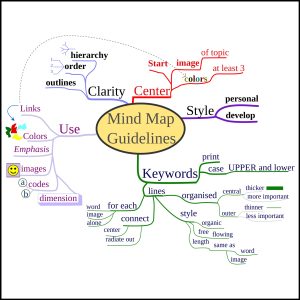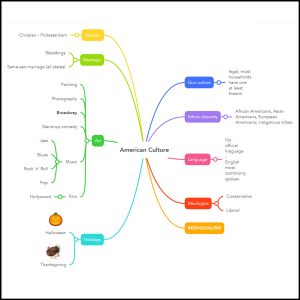 Note-taking is an essential skill for any student who wants to succeed in their education. However, many students struggle with taking effective notes that help them organize and retain information. Traditional note-taking methods, such as linear or outline notes, can be limiting and boring. They often fail to capture the connections and relationships between different ideas, and they can make it hard to review and recall information later.
Note-taking is an essential skill for any student who wants to succeed in their education. However, many students struggle with taking effective notes that help them organize and retain information. Traditional note-taking methods, such as linear or outline notes, can be limiting and boring. They often fail to capture the connections and relationships between different ideas, and they can make it hard to review and recall information later.
If you are looking for a better way to take notes, you might want to try mind-mapping. Mind-mapping is a creative and visual way of taking notes that can help you improve your learning and memory. Here, we explore what mind-mapping is, what are some strategies for using mind-mapping, and how to get started with mind-mapping for note-taking.
What is mind-mapping?
Credit: Nicoguaro
License: https://creativecommons.org/licenses/by-sa/3.0/deed.en
Changes: black, square border added
Mind-mapping is a technique that involves drawing a diagram that represents a central topic and its related subtopics and details. A mind map usually consists of a central node that contains the main idea or theme of the note, and several branches that radiate from it. Each branch represents a subtopic or a key point that is related to the central topic. The branches can have further sub-branches that contain more details or examples. A mind map can also include images, symbols, colors, or keywords to make it more attractive and memorable.
Mind-mapping was popularized by Tony Buzan, a British psychologist and author who wrote several books on the topic. He claimed that mind-mapping can help people use both sides of their brain, enhance their creativity, and improve their memory and recall. Mind-mapping has been widely used for various purposes, such as brainstorming, problem-solving, planning, studying, and presenting.
What are the benefits of using mind-mapping for note-taking?
 Mind-mapping can offer many benefits for students who want to take effective notes. Some of the benefits are:
Mind-mapping can offer many benefits for students who want to take effective notes. Some of the benefits are:
- Mind-mapping can help you organize your thoughts and information in a clear and logical way. You can see the big picture and the details of your notes at a glance, without having to read through long paragraphs or bullet points. You can also easily add, delete, or rearrange information on your mind map as you learn new things or revise your notes.
- Mind-mapping can help you understand the concepts and ideas that you are learning better. By creating a mind map, you are actively engaging with the material and making connections between different pieces of information. You are also using your own words and symbols to represent the information, which can help you process it more deeply and meaningfully.
- Mind-mapping can help you remember the information that you have learned more effectively. According to the dual-coding theory, people tend to remember information better when they encode it in both verbal and visual forms. By using words and images on your mind map, you are creating multiple cues that can trigger your memory later. Moreover, by reviewing your mind map regularly, you can reinforce your memory and recall the information more easily.
- Mind-mapping can help you creatively explore new ideas and perspectives on the topic that you are learning. By using a mind map, you can generate more associations and insights that might not occur to you otherwise. You can also use different colors, shapes, or styles to express your emotions or opinions on the topic. As noted by EdrawMind, a professional mind mapping tool provider, “Mind maps for note-taking are one of the best ways to regain and retain every information that you must have learned during your lecture or meeting. It is one of the finest ways to brainstorm, gain ideas, and get a fresh perspective on the topic”.
How to get started with mind-mapping for note-taking
Credit: Vmarss
License: https://creativecommons.org/licenses/by-sa/4.0/deed.en
Changes: black, square border added
If you are interested in using mind-mapping for note-taking, here are some steps that you can follow to get started:
- Choose a tool or a medium for creating your mind map. You can use a pen and paper, a whiteboard, or a digital tool such as EdrawMind, which is a powerful and easy-to-use mind-mapping software that allows you to create and edit mind maps on your computer or mobile device. You can also use EdrawMind to export your mind maps to various formats, such as PDF, PNG, Word, or PowerPoint.
- Start with a central topic or question that you want to take notes on. Write it in the center of your paper or screen, and draw a circle around it. This will be the main node of your mind map.
- Add branches for the main subtopics or key points that are related to the central topic. Write them on the branches, and draw circles around them. These will be the first-level nodes of your mind map.
- Add sub-branches for the details or examples that support each subtopic or key point. Write them on the sub-branches, and draw circles around them. These will be the second-level nodes of your mind map. You can add more levels of nodes as needed, depending on the complexity and depth of your notes.
- Use images, symbols, colors, or keywords to make your mind map more attractive and memorable. You can use images to illustrate concepts or ideas, symbols to indicate relationships or categories, colors to highlight important or relevant information, or keywords to summarize or emphasize points. You can also use different fonts, sizes, or styles to differentiate between different types of information.
- Review and revise your mind map as you learn more about the topic or as you review your notes. You can add, delete, or rearrange information on your mind map as you see fit. You can also use your mind map as a study tool by testing yourself on the information that you have learned.
Conclusion
Mind-mapping is a creative and visual way of taking notes that can help you improve your learning and memory. By using mind-mapping for note-taking, you can organize your thoughts and information in a clear and logical way, understand the concepts and ideas that you are learning better, remember the information that you have learned more effectively, and creatively explore new ideas and perspectives on the topic that you are learning.
Next Steps
 Now that you have learned how to use mind-mapping for note-taking, you might be wondering what to do next. Here are some suggestions:
Now that you have learned how to use mind-mapping for note-taking, you might be wondering what to do next. Here are some suggestions:
- Practice mind-mapping regularly. The more you use mind-mapping for note-taking, the more comfortable and proficient you will become. You can use mind-mapping for any subject or topic that you are learning, whether it is in class, online, or on your own.
- Experiment with different tools and styles. You can try different mediums and tools for creating your mind maps, such as paper, whiteboard, or digital software. You can also try different styles and formats for your mind maps, such as using different colors, shapes, or symbols. Find what works best for you and your preferences.
- Share your mind maps with others. You can share your mind maps with your classmates, friends, or teachers to get feedback, suggestions, or ideas. You can also use your mind maps to teach others what you have learned or to collaborate on projects or assignments.
- Share this post with your study group and unlock the exponential power of a community of mind-mappers.



